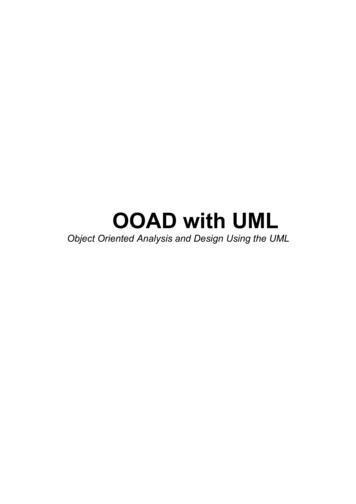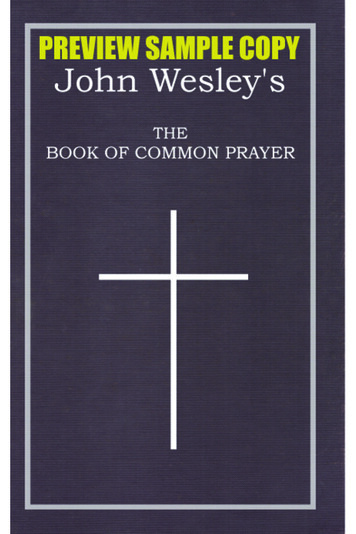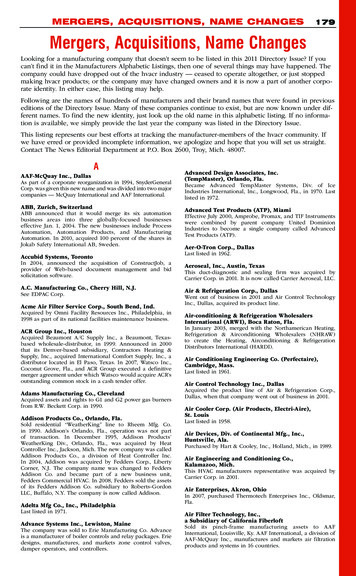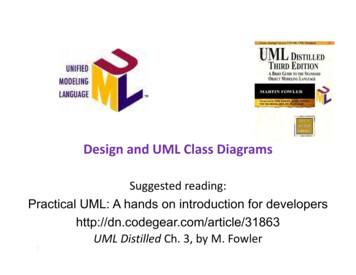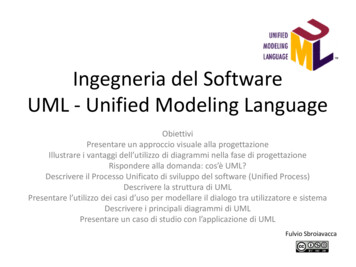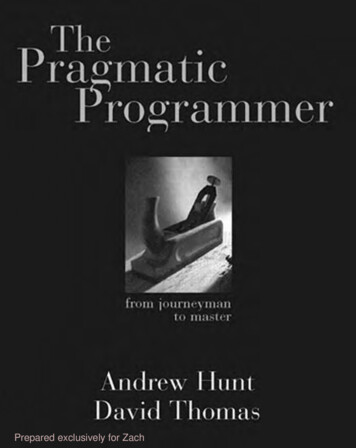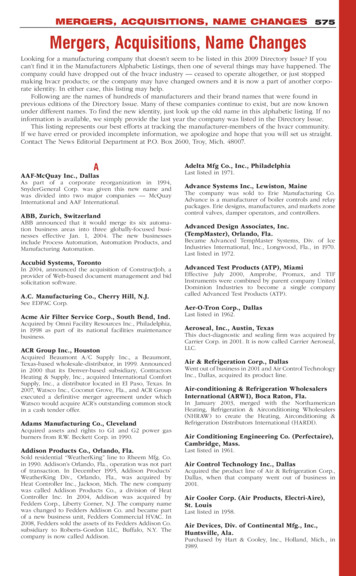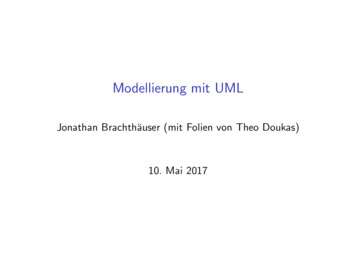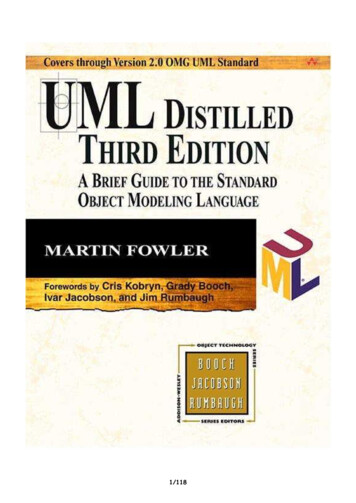
Transcription
1/118
FOREWORD TO THE THIRD EDITION . 4FOREWORD TO THE FIRST EDITION. 5PREFACE . 5Why Bother with the UML?. 6Structure of the Book. 7Changes for the Third Edition. 7Acknowledgments . 7DIAGRAMS . 10CHAPTER 1. INTRODUCTION . 14What Is the UML?. 14Where to Find Out More . 14Ways of Using the UML . 15How We Got to the UML . 18Notations and Meta-Models. 20UML Diagrams. 21What Is Legal UML?. 23The Meaning of UML. 24UML Is Not Enough. 24Where to Start with the UML. 25CHAPTER 2. DEVELOPMENT PROCESS . 26Iterative and Waterfall Processes. 26Predictive and Adaptive Planning. 28Agile Processes. 29Rational Unified Process. 30Fitting a Process to a Project. 30Fitting the UML into a Process . 32Choosing a Development Process. 35Where to Find Out More . 35CHAPTER 3. CLASS DIAGRAMS: THE ESSENTIALS . 35Properties. 36When to Use Class Diagrams . 38Where to Find Out More . 38Multiplicity. 38Programming Interpretation of Properties . 39Bidirectional Associations. 41Operations. 42Generalization. 43Notes and Comments . 44Dependency. 44Constraint Rules. 46CHAPTER 4. SEQUENCE DIAGRAMS . 47Creating and Deleting Participants. 50Loops, Conditionals, and the Like. 51Synchronous and Asynchronous Calls. 54When to Use Sequence Diagrams. 54CHAPTER 5. CLASS DIAGRAMS: ADVANCED CONCEPTS . 56Keywords . 56Classification and Generalization. 57Multiple and Dynamic Classification. 57Association Class . 58Template (Parameterized) Class. 61Enumerations. 62Active Class . 63Visibility . 63Messages. 64Responsibilities. 64Static Operations and Attributes. 65Aggregation and Composition. 65Derived Properties. 66Interfaces and Abstract Classes. 67Read-Only and Frozen. 70Reference Objects and Value Objects. 70Qualified Associations. 71CHAPTER 6. OBJECT DIAGRAMS . 722/118
When to Use Object Diagrams. 72CHAPTER 7. PACKAGE DIAGRAMS . 73Packages and Dependencies. 74Package Aspects. 76Implementing Packages. 76When to Use Package Diagrams. 77Where to Find Out More . 78CHAPTER 8. DEPLOYMENT DIAGRAMS . 78When to Use Deployment Diagrams. 79CHAPTER 9. USE CASES . 79Content of a Use Case. 80Use Case Diagrams . 81Levels of Use Cases . 82Use Cases and Features (or Stories) . 82When to Use Use Cases. 83Where to Find Out More . 83CHAPTER 10. STATE MACHINE DIAGRAMS . 83Internal Activities . 85Activity States . 85Superstates. 86Concurrent States. 86Implementing State Diagrams. 87When to Use State Diagrams. 89Where to Find Out More . 89CHAPTER 11. ACTIVITY DIAGRAMS . 89Decomposing an Action. 91And There's More. 93When to Use Activity Diagrams. 93Where to Find Out More . 93Partitions . 93Signals. 94Tokens. 95Flows and Edges. 96Pins and Transformations. 96Expansion Regions . 97Flow Final. 98Join Specifications. 99CHAPTER 12. COMMUNICATION DIAGRAMS . 100When to Use Communication Diagrams. 101CHAPTER 13. COMPOSITE STRUCTURES . 101When to Use Composite Structures. 103CHAPTER 14. COMPONENT DIAGRAMS . 103When to Use Component Diagrams . 105CHAPTER 15. COLLABORATIONS . 105When to Use Collaborations. 107CHAPTER 16. INTERACTION OVERVIEW DIAGRAMS . 107When to Use Interaction Overview Diagrams . 108CHAPTER 17. TIMING DIAGRAMS . 109When to Use Timing Diagrams. 110APPENDIX CHANGES BETWEEN UML VERSIONS . 110Revisions to the UML. 110Changes in UML Distilled. 111Changes from UML 1.0 to 1.1 . 112Changes from UML 1.2 (and 1.1) to 1.3 (and 1.5). 113Changes from UML 1.3 to 1.4 . 114Changes from UML 1.4. to 1.5 . 114From UML 1.x to UML 2.0. 114BIBLIOGRAPHY. 1163/118
Foreword to the Third EditionSince ancient times, the most talented architects and the most gifted designers have known the lawof parsimony. Whether it is stated as a paradox ("less is more"), or a koan ("Zen mind is beginner'smind"), its wisdom is timeless: Reduce everything to its essence so that form harmonizes withfunction. From the pyramids to the Sydney Opera House, from von Neumann architectures to UNIXand Smalltalk, the best architects and designers have strived to follow this universal and eternalprinciple.Recognizing the value of shaving with Occam's Razor, when I architect and read I seek projects andbooks that adhere to the law of parsimony. Consequently, I applaud the book you are reading now.You may find my last remark surprising at first. I am frequently associated with the voluminous anddense specifications that define the Unified Modeling Language (UML). These specifications allow toolvendors to implement the UML and methodologists to apply it. For seven years, I have chaired largeinternational standardization teams to specify UML 1.1 and UML 2.0, as well as several minorrevisions in between. During this time, the UML has matured in expressiveness and precision, but ithas also added gratuitous complexity as a result of the standardization process. Regrettably,standardization processes are better known for design-by-committee compromises thanparsimonious elegance.What can a UML expert familiar with the arcane minutiae of the specification learn from Martin'sdistillation of UML 2.0? Quite a bit, as can you. To start with, Martin adroitly reduces a large andcomplex language into a pragmatic subset that he has proven effective in his practice. He hasresisted the easy route of tacking on additional pages to the last edition of his book. As the languagehas grown, Martin has kept true to his goal of seeking the "fraction of UML that is most useful" andtelling you just that. The fraction he refers to is the mythical 20 percent of UML that helps you do 80percent of your work. Capturing and taming this elusive beast is no mean accomplishment!It is even more impressive that Martin achieves this goal while writing in a wonderfully engagingconversational style. By sharing his opinions and anecdotes with us, he makes this book fun to readand reminds us that architecting and designing systems should be both creative and productive. Ifwe pursue the parsimony koan to its full intent, we should find UML modeling projects to be asenjoyable as we found finger-painting and drawing classes in grammar school. UML should be alightning rod for our creativity as well as a laser for precisely specifying system blueprints so thatthird parties can bid and build those systems. The latter is the acid test for any bona fide blueprintlanguage.So, while this may be a small book, it is not a trivial one. You can learn as much from Martin'sapproach to modeling as you can learn from his explanations of UML 2.0.I have enjoyed working with Martin to improve the selection and correctness of the UML 2.0language features explained in this revision. We need to keep in mind that all living languages, bothnatural and synthetic, must evolve or perish. Martin's choices of new features, along with yourpreferences and those of other practitioners, are a crucial part of the UML revision process. Theykeep the language vital and help it evolve via natural selection in the marketplace.Much challenging work remains before model-driven development becomes mainstream, but I amencouraged by books like this that explain UML modeling basics clearly and apply thempragmatically. I hope you will learn from it as I have and will use your new insights to improve yourown software modeling practices.Cris KobrynChair, U2 Partners' UML 2.0 Submission TeamChief Technologist, Telelogic4/118
Foreword to the First EditionWhen we began to craft the Unified Modeling Language, we hoped that we could produce a standardmeans of expressing design that would not only reflect the best practices of industry, but would alsohelp demystify the process of software system modeling. We believed that the availability of astandard modeling language would encourage more developers to model their software systemsbefore building them. The rapid and widespread adoption of the UML demonstrates that the benefitsof modeling are indeed well known to the developer community.The creation of the UML was itself an iterative and incremental process very similar to the modelingof a large software system. The end result is a standard built on, and reflective of, the many ideasand contributions made by numerous individuals and companies from the object community. Webegan the UML effort, but many others helped bring it to a successful conclusion; we are grateful fortheir contribution.Creating and agreeing on a standard modeling language is a significant challenge by itself. Educatingthe development community, and presenting the UML in a manner that is both accessible and in thecontext of the software development process, is also a significant challenge. In this deceptively shortbook, updated to reflect the most recent changes to the UML, Martin Fowler has more than met thischallenge.In a clear and friendly style, Martin not only introduces the key aspects of UML, but also clearlydemonstrates the role UML plays in the development process. Along the way, we are treated toabundant nuggets of modeling insight and wisdom drawn from Martin's 12-plus years of design andmodeling experience.The result is a book that has introduced many thousands of developers to UML, whetting theirappetite to further explore the many benefits of modeling with this now standard modelinglanguage.We recommend the book to any modeler or developer interested in getting a first look at UML and ingaining a perspective on the key role it plays in the development process.Grady BoochIvar JacobsonJames RumbaughPrefaceI've been lucky in a lot of ways in my life; one of my great strokes of fortune was being in the rightplace with the right knowledge to write the first edition of this book in 1997. Back then, the chaoticworld of object-oriented (OO) modeling was just beginning to unify under the Unified ModelingLanguage (UML). Since then, the UML has become the standard for the graphical modeling ofsoftware, not just for objects. My fortune is that this book has been the most popular book on theUML, selling more than a quarter of a million copies.Well, that's very nice for me, but should you buy this book?I like to stress that this is a brief book. It's not intended to give you the details on every facet of theUML, which has grown and grown over the years. My intention is to find that fraction of the UML thatis most useful and tell you just that. Although a bigger book gives you more detail, it also takeslonger to read. And your time is the biggest investment you'll make in a book. By keeping this booksmall, I've spent the time selecting the best bits to save you from having to do that selectionyourself. (Sadly, being smaller doesn't mean proportionately cheaper; there is a certain fixed cost toproducing a quality technical book.)5/118
One reason to have this book is to begin to learn about the UML. Because this is a short book, it willquickly get you up to speed on the essentials of the UML. With that under your belt, you can go intomore detail on the UML with the bigger books, such as the User Guide [Booch, UML user] or theReference Manual [Rumbaugh, UML Reference].This book can also act as a handy reference to the most common parts of the UML. Although thebook doesn't cover everything, it's a lot lighter to carry around than most other UML books.It's also an opinionated book. I've been working with objects for a long time now, and I havedefinite ideas about what works and what doesn't. Any book reflects the opinions of the author, andI don't try to hide mine. So if you're looking for something that has a flavor of objectivity, you mightwant to try something else.Although many people have told me that this book is a good introduction to objects, I didn't write itwith that in mind. If you are after an introduction to OO design, I suggest Craig Larman's book[Larman].Many people who are interested in the UML are using tools. This book concentrates on the standardand on conventional usage of the UML and doesn't get into the details of what various tools support.Although the UML did resolve the tower of Babel of pre-UML notations, many annoying differencesremain between what tools show and allow when drawing UML diagrams.I don't say much in this book about Model Driven Architecture (MDA). Although many peopleconsider the two to be the same thing, many developers use the UML without being interested inMDA. If you want to learn more about MDA, I would start with this book to get an overview of theUML first and then move on to a book that's more specific about MDA.Although the main point of this book is the UML, I've also added bits of other material abouttechniques, such as CRC cards, that are valuable for OO design. The UML is just a part of what youneed to succeed with objects, and I think that it's important to introduce you to some othertechniques.In a brief book like this, it's impossible to go into detail about how the UML relates to source code,particularly as there is no standard way of making that correspondence. However, I do point outcommon coding techniques for implementing pieces of the UML. My code examples are in Java andC#, as I've found that these languages are usually the most widely understood. Don't assume that Iprefer those languages; I've done too much Smalltalk for that!Why Bother with the UML?Graphical design notations have been with us for a while. For me, their primary value is incommunication and understanding. A good diagram can often help communicate ideas about adesign, particularly when you want to avoid a lot of details. Diagrams can also help you understandeither a software system or a business process. As part of a team try
quickly get you up to speed on the essentials of the UML. With that under your belt, you can go into more detail on the UML with the bigger books, such as the User Guide [Booch, UML user] or the Reference Manual [Rumbaugh, UML Reference]. This book can also act as a handy re
